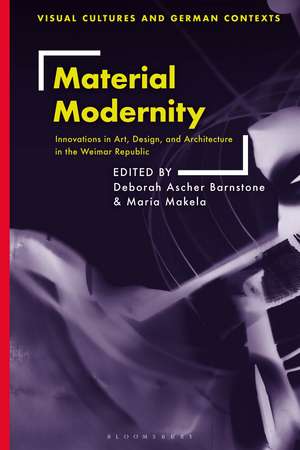Material Modernity: Innovations in Art, Design, and Architecture in the Weimar Republic: Visual Cultures and German Contexts
Editat de Deborah Ascher Barnstone, Maria Makelaen Limba Engleză Paperback – 24 ian 2024
| Toate formatele și edițiile | Preț | Express |
|---|---|---|
| Paperback (1) | 192.55 lei 6-8 săpt. | |
| Bloomsbury Publishing – 24 ian 2024 | 192.55 lei 6-8 săpt. | |
| Hardback (1) | 543.66 lei 3-5 săpt. | |
| Bloomsbury Publishing – 26 ian 2022 | 543.66 lei 3-5 săpt. |
Preț: 192.55 lei
Preț vechi: 250.01 lei
-23% Nou
Puncte Express: 289
Preț estimativ în valută:
36.85€ • 38.33$ • 30.42£
36.85€ • 38.33$ • 30.42£
Carte tipărită la comandă
Livrare economică 14-28 aprilie
Preluare comenzi: 021 569.72.76
Specificații
ISBN-13: 9781350228740
ISBN-10: 1350228745
Pagini: 240
Ilustrații: 8 colour and 54 bw illus
Dimensiuni: 156 x 234 x 25 mm
Greutate: 0.4 kg
Editura: Bloomsbury Publishing
Colecția Bloomsbury Visual Arts
Seria Visual Cultures and German Contexts
Locul publicării:London, United Kingdom
ISBN-10: 1350228745
Pagini: 240
Ilustrații: 8 colour and 54 bw illus
Dimensiuni: 156 x 234 x 25 mm
Greutate: 0.4 kg
Editura: Bloomsbury Publishing
Colecția Bloomsbury Visual Arts
Seria Visual Cultures and German Contexts
Locul publicării:London, United Kingdom
Caracteristici
Presents new material on a much-studied period of German art history, offering a fresh way of understanding the avant-garde and its innovations
Notă biografică
Deborah Ascher Barnstone is Professor of Architecture and Head of the School of Architecture, Landscape Architecture, and Interior Architecture at University of Technology Sydney, Australia. She studied at Columbia University, USA and Delft University of Technology, the Netherlands. A licensed architect as well as an art historian, her primary research interests are classical modernism in German art and architecture. Ascher Barnstone has a particular interest in dismantling historical myths by re-examining received histories in order to uncover alternate interpretations of the past. She has published widely in such scholarly publications as Journal of Architectural Education, Journal of Architecture, and New German Critique and in edited volumes. Her recent monograph works include Beyond the Bauhaus: Cultural Modernity in Breslau, 1918-1933 (2016), Art and Resistance in Germany (2018), and The Break with the Past: Avant-garde Architecture in Germany, 1910-1925 (2019). She co-edits the Visual Cultures and German Contexts book series.Maria Makela is Professor Emerita of the California College of the Arts, USA. She holds a PhD in art history from Stanford University. Makela has published widely in exhibition catalogues, edited anthologies, and periodicals on topics as diverse as fashion, rayon, New Objectivity, Dada, Expressionism, film, nationalism, sexology, and typology. Much of her research has focused on gender and sexuality in visual culture. She is the author of The Munich Secession: Art and Artists in Turn-of-the-Century Munich (1990) and co-editor of Of Truths Impossible to Put in Words: Max Beckmann Contextualized (2009). In 1996 she co-curated a traveling retrospective of the work of Hannah Höch and co-authored the accompanying catalog, The Photomontages of Hannah Höch. Makela serves on the editorial board of German Quarterly and on the advisory board of the Visual Cultures and German Contexts book series, which publishes under the Bloomsbury Visual Arts imprint.
Cuprins
List of Illustrations1. IntroductionI New Materials in Artistic Applications 2. Making Lemonade out of Lemons: Merz and Material Property, Maria Makela3. Experimentation and Invention at Weaving at the Bauhaus, Isabel Wünsche4. Paper Promises: Inflation and the Insufficiency of Ersatz in Weimar Germany, Erin Sullivan Maynes5. Abject Objects: Til Brugman, Evidentiary Representation, and Sexology's Celluloid Fixation, Thomas O. Haakenson II New Chemicals and Reprographic Processes6. Visual Explosion in the Weimar Era's Print Media, Andres Mario Zervigon7. Lazlo MoholyNagy: Adventures in Light, Space and Time, Donna West BrettIII Traditional Materials in New Applications8. The Emperor's New Glass: Transparency as Substance and Symbol in Interwar Design, Freyja Hartzell9. Inverted Cubism or the Spatial Painting: Adolf Rading's House Dr. Rabe, Deborah Ascher Barnstone 10. Renee Sintenis, Wendt & Kühn, Lotte Pritzel: Modes, Markets, and Materials in Domestic Objects, 1910-1930, Nina LübbrenContributorsIndex














